Tips For Working With The Press
In today’s fast-paced media landscape, news editors face a deluge of press releases meaning they must make rapid decisions about which stories to cover and publish.
Effectively communicating with members of the press and using guidelines will help enhance the chances of your event being attended by a member of the media and/or your story being published.
The two written communication tools are press releases and media advisories.
What is a Press Release?
A press release (also known as a news release) is formal written communication announcing something newsworthy about a business. Example: Ribbon cutting ceremony or other event; receipt of an award; announcement of new employee, etc.
It typically follows a specific format: Headline, dateline, body paragraphs with the main information, quotes from key individuals, and contact information for media inquiries.
Many times, the information will be copied and pasted from the press release. Please refer to the Formatting Tips.
Ideally, all factors should be locked down at least 60 days in advance.
What is a Media Advisory?
A media advisory (also known as a media alert or press advisory) is shorter than a press release. However, the same Formatting Tips for a press release apply.
It serves as an invitation for members of the media to attend an upcoming event or press conference for media coverage.
Unlike a press release, a media advisory does not contain the full story. It highlights the key details of the event: Who, what, when, where, and why; along with the logistical information such as location.
Sending a media advisory well in advance of your event is a crucial step in garnering media coverage. However, it is important to understand this does not guarantee they will attend Additionally, journalist typically do not confirm their attendance in advance. The section Hosting Members of the Media explains why.
Writing A Press Release:
Headline
Craft a compelling headline to catch the editor’s attention. While the rest of the release should remain in a standard format, the headline can be bold and centered. The editor will likely re-write the headline.
First Paragraph
Begin with the city and state of the business or event location. This helps editors determine where to publish the release if they operate across multiple geographic locations. It is typically styled like: FORT EDWARD, NY—
Body of the Press Release
Structure the body with the essential elements: who, what, when, where, and why. Keep language clear and concise and avoid unnecessary jargon.
Include Photos
Select 3 to 4 high-quality photos that best the story or represent the business or event. List the file name of each photo and provide a description of what is in the photo. If people are in the photo provide their names, listed by row and left to right.
Be mindful of safety hazards, health code violations, etc. that might be demonstrated in the photo.
Be sure to obtain permission from parents/guardians if minors are in photos.
Be sure to obtain permission to use photos taken by professional photographers and provide the appropriate photo credits.
Last Paragraph
Include website and social media links for further information. Provide a contact name and information in case additional information is sought from the media outlet.
End Of The Press Release
At the end of the press release include:
# # #
This lets the editor know the end of the media advisory or press release.
FORMATTING TIPS:
To increase the chances of your press release being published, it’s essential to ensure it can be swiftly copied and pasted with minimal reformatting by the media outlet.
Keep formatting simple to facilitate easy copying and pasting. Avoid bold, italics, bullet points, and excessive styling.
Choose a sans-serif font for readability.
Distributing Media Advisories and Press Releases:
Be sure the subject line is not empty – “Media Advisory” or “Press Release” is sufficient
Copy and paste the media advisory or press release into the body of the e-mail. Editors do not want to download files other than photos. They want to simply copy and paste with minimal formatting. Please refer to Formatting Tips for Media Advisories and Press Releases
If have a personal contact at a media outlet, you should send the e-mail directly to that individual. You may also want to send a personal message.
If you are sending via mass distribution to several media outlets, be sure to send it using BCC:
- It protects the privacy of each recipient
- It demonstrates professionalism in your communication in that you understand e-mail etiquette.
You will equally benefit by using BCC since each recipient receives the e-mail individually. This makes it easier for you to track your responses, interactions, and any follow-ups.
Don’t forget to attach the photos!
Ideally, all factors should be locked down at least 60 days in advance.
Hosting Members of the Media:
Journalists receive numerous advisories daily. They need to assess the newsworthiness of the numerous events they are invited to and prioritize them. They will do this closer to the event date and determine where they are going to commit their resources.
Journalists need to remain flexible to cover breaking news or last-minute developments.
Though media members typically do not commit to which events they will attend, have a plan in place should they show up. The easier you make their job, the more likely they will want to work with you again and cover future events.
This can be achieved by:
- Providing clear directions and parking information. If possible, reserve parking spaces specifically for the media to make their arrival and departure convenient.
- Providing a media kit containing the essential information about the business, the event agenda/program, bios of key speakers or participants, etc.
- Designating a point person (or people) to serve as the primary contact. This person should greet the media, help them sign in if required by the venue, escort them to the event space, and coordinate interviews with the key figures/speakers.
- Consider providing a media room where media can work and file their stories.
Be sure to follow up with the media after the event to thank them for their coverage and inquire if they need additional information.
Following Up:
Once your story has been published or event has been attended by a member of the media, it is time to continue cultivating or maintaining the relationship. Be sure to thank them for their coverage.
For stories published online be sure to link them to your business’s website and share them on your social media platforms. Be sure to tag the media outlet and the specific journalist.
Do not take photos of the story and post them online. This is a copyright violation, and the media outlet and journalist will not be happy with you since this could reduce potential sales of their product and reduce traffic to their website and/or media outlets.






